GlideTV Navigator
|
GlideTV Navigator Review The GlideTV Navigator has gained a significant amount of buzz recently, |
Introduction
The GlideTV Navigator is the first release from company GlideTV, Inc and made its first headlines earlier this year at the Consumer Electronic Show (CES) winning the Best of Innovations Award for it. The company manufacturers the unique device which is compatible with Windows (XP, Vista and 7), Mac and the PlayStation 3 gaming device.
Let’s take a look at the product specs according to the company:
• Clickable touchpad mapped to your TV screen – precise cursor control, one-thumb scrolling, single and double-click selection.
• Backlit AV buttons to control volume and playback.
• Directional buttons for easy two-axis navigation.
• Dedicated Esc, Enter, Back, and Function keys to control applications.
• On-screen keyboard. (Windows only)
• Integrated search menu with links to
Google, Amazon Video on Demand, Hulu, Netflix, YouTube and more. (Windows only)
• Rechargeable battery.
And then the pitch…
From movies to TV shows, from music services to radio stations, it’s all there at a click of a mouse.
But try to access it from your TV using an HTPC and you’ll discover that you need to balance a whole office on your knees…from a full keyboard to a mouse and a pad. And if you use a universal remote, you’ll discover that two-axis movement is not enough to navigate today’s websites. The experience becomes cumbersome, even frustrating.
That’s where GlideTV Navigator comes in…it combines the functionality of a keyboard, mouse and AV remote in an elegant device that fits the palm of your hand.
GlideTV is the easiest way to surf the net from your TV…head-up and leaning-back.
So let’s see what all this hype is about!
A Look at the Hardware
From the initial packaging to the foam inside, the GlideTV just oozes style and glamour. Sliding the box open you find everything neatly tucked away inside the package. Front and center of course, is the GlideTV Navigator device itself. Tucked away in parts of the foam are the user manual, USB RF receiver, Charging Connector, USB Cable and the charging cradle.
| Unboxing the unit | Clockwise from the Top: User guide, AC plug, charging cradle, GlideTV Navigator, USB RF Receiver, USB Cable |
I used a quarter to try to give you a point of reference as to the overall size of the unit. It’s not as small as you might imagine, even though one of the press photos is pretty accurate with the device in the palm of a hand as shown below.
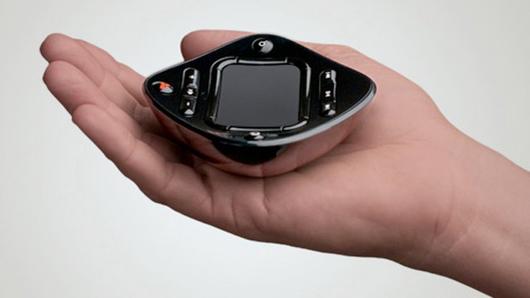
Charging the device is quite simple, as the cradle can be placed either near an outlet or directly connected to the USB port on any PC system. It’s a nice surprise after playing with some other devices (such as the Harmony 700) which does not allow charging via USB ports. The battery is of course rechargeable, and the manual states you should have about two weeks worth of usage out of a full charge, but of course that will all depend on how often you use it.
The manual is quite thin, but the full user guide is available online. This is more important than you might think, as there are only brief commands mentioned in the paper guide but lots of useful shortcuts available via the guide online.
|
|
|
| Height compared to a quarter | Navigator layout, from top: GlideTV button, Volume, Power, Touchpad & Navigation (8 directions), Search, Skip/Rewind/Play/Pause |
Finally, you can actually use the device right away without having to install a single thing. The remote works off of universal control device shortcuts for a lot of the tasks which makes using it a snap. I found myself switching between my laptop and my HTPC during some of my testing as I had a variety of online content on the laptop but didn’t feel like holding it.
Here’s a video of using the device, with some shortcuts in use:
Note, there is a correction to the video review–the device DOES have
STOP functionality, by holding down the Play/Pause button. Also, holding down the Skip Forward/Back will begin fast
forwarding or rewinding and will increase in speed the longer you continue to hold down
Software
As I mentioned earlier, the software included with the GlideTV is not required to utilize the Navigator. That being said, unless you are strictly using the device for a single application, the application does make using a variety of applications easier. So let’s take a closer look…
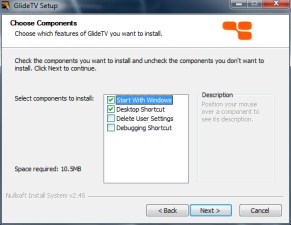 |
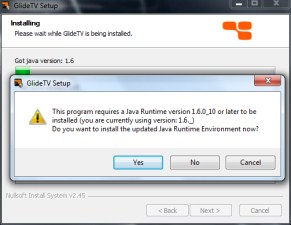 |
| Standard Install settings | Java is a requirement |
Installation is pretty small and the application gives you the option of launching with Windows (recommended), and places a small GlideTV icon in the upper right of the screen (which you can choose to hide). You can access the software by simply pressing the orange GlideTV button on the top of the device. Clicking it launches a 10′ application launcher software which grants you easy access to some pre-determined shortcuts.
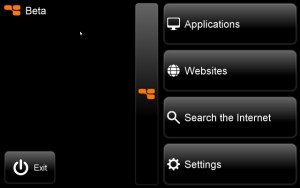
|
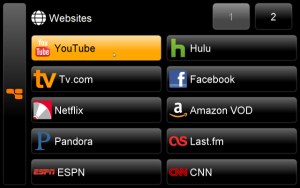
|
| GlideTV 10′ Main User Interface | Websites Page (default) |
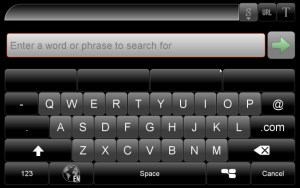 |
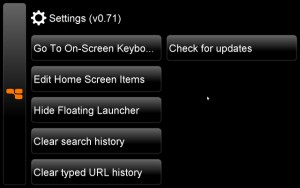 |
| On-Screen Keyboard | Settings Page |
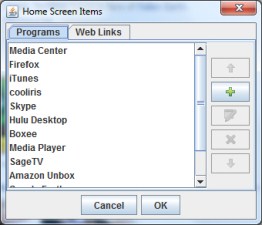
|
| Configure the Programs and Websites |
Since the remote only has the main GlideTV button which is not configurable, the software allows you to get to applications like Media Center or Hulu Desktop from an easy to see 10′ interface. Note, the pictures shown below are the defaults, but both the applications and the websites are configurable as well.
|
|
| GlideTV’s 10′ Interface in action |
The 10′ applications are fine and fun, but since you can easily use a remote control with those they really fail to highlight the unique capabilities of the GlideTV Navigator. This is where Firefox is really a fantastic application. For whatever reason you may have–be it web browsing for news, or videos or anything else–the Navigator allows you to do this from the convenience of your sofa without sacrificing functionality. With the help of the GlideTV folks we found a couple very useful Firefox add-ons which make browsing with the Navigator seamless:
- FoxTab – Provides a unique way to browse through your tabs with previewing
- Full Fullscreen – Designed for kiosk applications, this hides all the toolbars from Firefox
- Grab and Drag – Enables flick functionality for quick page scrolling (works in both modes but really slick in Absolute)
- Default Full Zoom Level – Allows you to have Firefox automatically zoomed in a bit. Makes reading text much easier
Once everything is set up you can start browsing freely. This is really where the GlideTV websites link makes life easier as well as favorites groups, which allow you to load groups of websites at a single time.
Here are some videos of the Web Browsing capabilities of the GlideTV. First up is the Grab and Drag plugin of Firefox:
And here’s a video of the FoxTabs interaction with the GlideTV:
Using the Device
One of the first things I quickly learned when playing with the GlideTV Navigator is that the device is not meant to be a remote control replacement, or a one-handed device…at least not entirely. The touchpad has a clicking functionality I have not used before but it makes it easier to use than the double tap on my laptop. The buttons surrounding the touchpad are raised and can be used in combination to access shortcuts (I’ll discuss further below). In addition, the remote has two types of modes–relative and absolute–both having unique benefits and being useful for certain applications.
|
|
| Video of GlideTV with Hulu Desktop Application |
"Relative" mode allows the unit to function how you would expect your laptop’s touchpad to behave, with the cursor on screen and moving it to the spot you want. In addition to the basic application described, this mode also allows for vertical and horizontal scrolling using the right and bottom edge of the touchpad to quick scroll. This is very useful in web browsing or with applications such as CoolIris; take a look at the video below to get a better feel for how it works:
|
|
| Scrolling using the GlideTV Navigator with the CoolIris Application |
"Absolute" mode is a much more unique experience, but one that takes a lot more time to become adjusted with. The concept is similar to what you may be familiar with tablet PC’s and touchpanels. Rather than sliding the cursor to the location you want, you simply press on the touchpad on the spot of the screen and the mouse will jump there–for example, if you want to close Media Center you touch the top right corner of the touch pad, and then click. I much preferred "Absolute" mode for applications like Media Center and Hulu Desktop, where I could easily click on the location desired and click.
|
|
| Relative versus Absolute Modes |
|
|
| Using the GlideTV to quickly navigate fast scrolling |
Final Thoughts
The GlideTV Navigator is a unique device that puts a different spin on one of the oldest control devices for computers. The Navigator sports a slick little package for controlling your computer from a distance with quickness and convenience. The shortcuts provide added flexibility as do the software package included with purchase.
That being said, the device is not without fault. First, is that while the device is small, its layout and size requires the use of both hands for full utilization. While basic control can be done single-handedly, most of the shortcuts required the use of my second hand. Not a showstopper at all, but that brings about the second fault–no included keyboard. Since the device requires two hands, I would not have minded seeing it a bit larger in size but with a keyboard. While the on-screen keyboard is simple to use, nothing beats having the keys at your fingertips.
I’ve been using the Logitech Dinovo Mini for several months and I found myself comparing the GlideTV Navigator to it for most of the review–especially considering they both have an MSRP of $150. In the end, I did not have a clear answer on which I would have chosen, the race was that close for me. I love the keyboard on the Dinovo but the touchpad on the GlideTV wins by a mile. In the end, I’d consider it a draw based on your needs. If you do a lot of chatting or typing from your sofa, then the Dinovo Mini is a better choice. However, if most of your activities can be done sans typing, then you will enjoy the flexibility the GlideTV brings.
One final note, and this was clear with the Dinovo Mini as well, is that this device is not meant as a complete remote control replacement. For normal usage via a 10′ application such as Media Center, your standard remote is more than capable. However, for the frequent tasks required with maintaining your HTPC, such as updates to software, or if some of your favorite video websites do not have a 10′ application this is where the GlideTV Navigator shines.
Pros:
- Very unique design
- Touchpad clicks down
- Cradle can charge from either USB or outlet
- Easy to use 10′ application for launching shortcuts
- RF Control provides far range
- Multiple modes for increased flexibility
- The best touchpad I’ve ever used
- Application shortcuts for launching certain tasks
Cons:
- $150 MSRP
- Windows7 Flick controls a work in progress
- Absolute mode not ideal for overscanned screens
- Not a remote replacement–volume/power buttons not device programmable
Thanks to GlideTV for providing the unit for review. Don’t forget to visit http://www.glidetv.com for all the latest information, and continue the discussion onward at our forums via the Comments button below.
